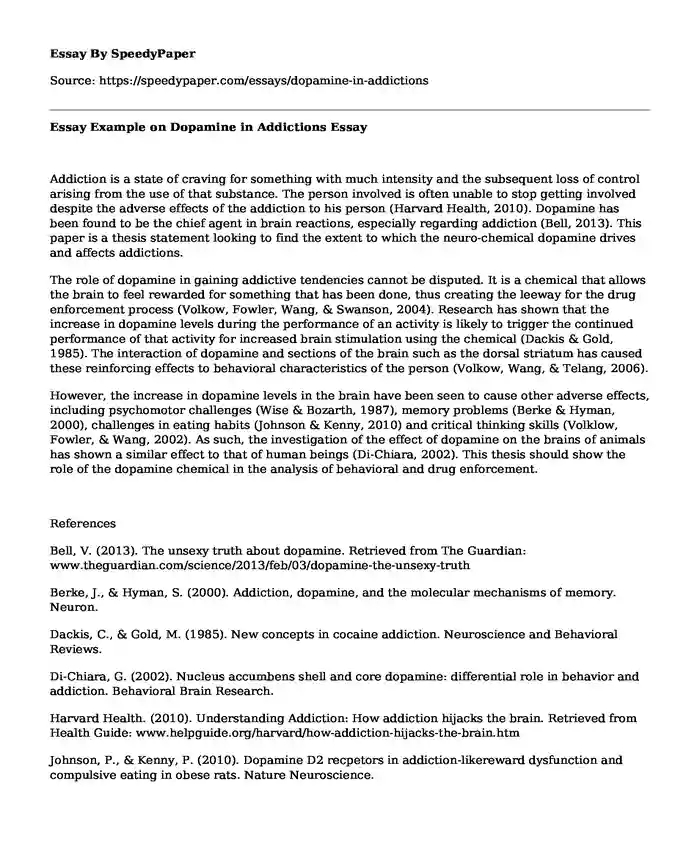Addiction is a state of craving for something with much intensity and the subsequent loss of control arising from the use of that substance. The person involved is often unable to stop getting involved despite the adverse effects of the addiction to his person (Harvard Health, 2010). Dopamine has been found to be the chief agent in brain reactions, especially regarding addiction (Bell, 2013). This paper is a thesis statement looking to find the extent to which the neuro-chemical dopamine drives and affects addictions.
The role of dopamine in gaining addictive tendencies cannot be disputed. It is a chemical that allows the brain to feel rewarded for something that has been done, thus creating the leeway for the drug enforcement process (Volkow, Fowler, Wang, & Swanson, 2004). Research has shown that the increase in dopamine levels during the performance of an activity is likely to trigger the continued performance of that activity for increased brain stimulation using the chemical (Dackis & Gold, 1985). The interaction of dopamine and sections of the brain such as the dorsal striatum has caused these reinforcing effects to behavioral characteristics of the person (Volkow, Wang, & Telang, 2006).
However, the increase in dopamine levels in the brain have been seen to cause other adverse effects, including psychomotor challenges (Wise & Bozarth, 1987), memory problems (Berke & Hyman, 2000), challenges in eating habits (Johnson & Kenny, 2010) and critical thinking skills (Volklow, Fowler, & Wang, 2002). As such, the investigation of the effect of dopamine on the brains of animals has shown a similar effect to that of human beings (Di-Chiara, 2002). This thesis should show the role of the dopamine chemical in the analysis of behavioral and drug enforcement.
References
Bell, V. (2013). The unsexy truth about dopamine. Retrieved from The Guardian: www.theguardian.com/science/2013/feb/03/dopamine-the-unsexy-truth
Berke, J., & Hyman, S. (2000). Addiction, dopamine, and the molecular mechanisms of memory. Neuron.
Dackis, C., & Gold, M. (1985). New concepts in cocaine addiction. Neuroscience and Behavioral Reviews.
Di-Chiara, G. (2002). Nucleus accumbens shell and core dopamine: differential role in behavior and addiction. Behavioral Brain Research.
Harvard Health. (2010). Understanding Addiction: How addiction hijacks the brain. Retrieved from Health Guide: www.helpguide.org/harvard/how-addiction-hijacks-the-brain.htm
Johnson, P., & Kenny, P. (2010). Dopamine D2 recpetors in addiction-likereward dysfunction and compulsive eating in obese rats. Nature Neuroscience.
Volklow, N., Fowler, J., & Wang, G. (2002). Role of dopamine, the frontal cortex and memory circuits in drug addiction: insights from imaging studies. Neurobiology of Learning.
Volkow, N., Fowler, J., Wang, G., & Swanson, J. (2004). Dopamine in drug abuse and addiction: results from imaging studies and treatment implications. Molecular Psychiatry, 557-69.
Volkow, N., Wang, G., & Telang, F. (2006). Cocaine cues and Dopamine in Dorsal Striatum: mechanism of craving in cocaine addiction. Journal of Neuroscience, 6583-88.
Wise, R., & Bozarth, M. (1987). A psychomotor stimulant theory of addiction. Psychological Review.
Cite this page
Essay Example on Dopamine in Addictions. (2019, Jun 24). Retrieved from https://speedypaper.com/essays/dopamine-in-addictions
Request Removal
If you are the original author of this essay and no longer wish to have it published on the SpeedyPaper website, please click below to request its removal:
- Essay Example on Service Management at British Airways
- Free Essay: A Sociological Perspective on Crime and Gang Violence in American Society
- Education Essay Sample on Public and Private Universities
- Essay Example on Women's Reproductive Rights in America
- Why the World Isn't Flat - Globalization Essay Example
- Essay Sample on the Validity of Quantitative Quasi-Experimental Research Design
- Free Essay: the Possibilities and Limits of Forgiveness
Popular categories





